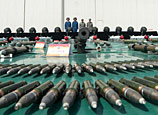
BEIJING, April 27 (Xinhua) -- A year after China widened the daily trading limit of its currency, the yuan, experts are arguing whether it is time to further enlarge the band to make the exchange rate more market oriented.
In mid April 2012, the People's Bank of China (PBOC), the country's central bank, decided to widen the yuan's daily trading limit against the U.S. dollar to 1 percent, up from the previous 0.5 percent.
The move, as announced by the China Foreign Exchange Trading System, has meant Chinese banks can exchange the yuan 1 percent above or below the central parity rate against the U.S. dollar on the spot market.
However, the expansion has proved somewhat inadequate, as the yuan's exchange rate on the spot market rose to the daily limit of 1 percent for 20 consecutive trading days at the end of 2012.
The yuan has showed strong momentum of appreciation since the beginning of this month. By Friday, the Chinese currency's central parity against the U.S. dollar had reached a historic high nine times in the month.
Yi Gang, vice governor of the PBOC, said in a seminar on the exchange rate arrangements of the International Monetary Fund last week that the central bank is currently considering further expanding the yuan's fluctuation limit.
Reforming toward a market-oriented exchange rate mechanism in a progressive manner is a clear direction for China to take, Yi said.
However, Cai Hongbo, an expert with Beijing Normal University, warned that in the context of the yuan's appreciation pressures, the market may misinterpret a further widening of the daily trading band as a signal of the PBOC's rising tolerance about the yuan's appreciation.
"That will further boost market expectation for the yuan's appreciation, which will be harmful for export and the supervision of international capital flow," according to Cai.
But considering China's overall macroeconomic situation, consensus if forming over the necessity of widening the band.
China's foreign trade is becoming increasingly balanced, the yuan's exchange rate is nearing the equilibrium level, and a general trend of two-way exchange rate fluctuation is coming into being, Cai said.

















 Heavy rain affects traffic in S China
Heavy rain affects traffic in S China


![]()
